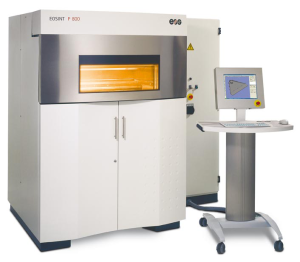Bell Helicopter received the first-ever certification for a commercial helicopter in 1946. Just five years prior, Arthur M Young demonstrated a model helicopter flying on a tether while working for Bell Aircraft Corporation. Today, the Texas company has made and sold more than 35,000 of the aircraft for a worldwide clientele.
Bell Helicopter is no stranger to 3D printing. Historically, the company has used it to produce prototype components, but they recently decided the time had come to 3D print functional parts. They turned to nearby additive manufacturing bureau Harvest Technologies (recently acquired by Stratasys) who has more than 40 AM machines, along with vast in-house expertise.
Bell Helicopter and Harvest needed to prove out the processing capabilities of the EOSINT P 730 plastic laser-sintering machine from EOS. In order to do this they examined the “heat distribution, powder degradation, dimensional accuracy, repeatability, component quality and performance, and the economics of manufacture that would be used to make the helicopter parts and to certify the platform for use in the aerospace industry.”
Elliott Schulte, Engineer III at Bell Helicopter said, “We characterized the mechanical properties of each additively manufactured build so that we could confirm that the EOS system met our specification requirements and produced the same quality product each time. The systematic testing was done with a number of different materials and across a series of individual builds to establish that EOS technology was robust and highly repeatable.”
Capability proven, Bell Helicopter and Harvest moved to the next step and began the meticulous process of manufacturing aerospace hardware, embracing the freedom of design that comes with 3D printing.
The head of Bell Helicopter’s rapid prototyping lab, Christopher Gravelle, commented, “Material characterization is a critical consideration for us during design. For instance, if we are creating bosses for attachment points in additively manufactured nylon rather than metal, it is a new material and process and you cannot just use the same configuration.”
Sounds like he has the “material optimization design solution” blues.
After a final review of the first component design for production, Bell Helicopter sent a 3D CAD model to Harvest to develop a build strategy. Everything is 100% by the book when you are responsible for flying humans through the sky, as it should be. Before each batch was produced, rigorous pre-production inspections were carried out by Harvest. This includes for example, checking to make sure that the nitrogen leak rate was low, which is important for reducing waste as well as ensuring part quality.
Caleb Ferrell, quality manager at Harvest said, “After every build, we test for tensile and flexural properties of the components. This is a requirement for process assurance that we continuously monitor. The parts that we get have very good feature definition and the mechanical properties have been good as well. We are especially happy with the larger platform size and the “nestability” we are achieving.”
Currently, the helicopter manufacturer 3D prints parts mainly for its environmental control system (ECS) using EOS technology. However, Bell Helicopter is interested in employing 3D printed components throughout the aircraft systems of its commercial helicopters.

Bell Helicopter has plans to evaluate the 3D printing of high-temperature plastics intended for more demanding roles and environments.
Ferrell explained, “In addition to the design advantages, there are significant manufacturing benefits with EOS technology. Tool-less manufacturing means you do not face certain limitations or up-front costs. If you need to change something, you can build new revisions simply by changing the CAD file – no molds, no new machining tool paths and very little wasted time and money. Because of the large build platform in the EOSINT P 730, we can print bigger components in one piece rather than in sections, eliminating assembly costs.”
According to Ron Clemons, director of business development at Harvest, another interesting advantage of the EOS system is the clean surface it produces. He said that the EOSINT P 730 “incorporates a software fix that provides crisper detail and smoother surfaces.” And as a result, there is “relatively little peripheral powder melting and adhesion, so the desired quality of finish is achieved.” Financially this proves beneficial by cutting down the post-processing cost compared with the Harvest’s other 3D printers.
One other attractive quality of EOS technology is the increased recyclability of the plastic powder. According to Bell Helicopter, other 3D printers used by Harvest left behind a substantial amount of partially sintered and unusable powder, compared with the EOSINT P 730.
This is probably why Harvest has acquired a second EOSINT P 730 as well as an additional EOSINT P 760. Harvest is currently working with Bell Helicopter to implement the manufacture of one-off or two-off orders for spare parts, nested within the build volumes of existing batch productions.



